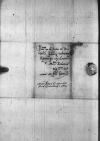Rogatum me habuit per litteras dominus Andrea Carducci ⌊Andreas CardutiusAndrea Carducci ⌋
s(erenissimae) or s(acrae)⌈s(erenissimae)s(erenissimae) or s(acrae)⌉
Bona Sforza (*1494 – †1557), Queen of Poland and Grand Duchess of Lithuania (1518-1557); the second wife of Sigismund I Jagiellon; Duchess of Bari and Rossano; daughter of Gian Galeazzo Sforza of Milan and Isabella of Aragon⌊maiestatis reginalisBona Sforza (*1494 – †1557), Queen of Poland and Grand Duchess of Lithuania (1518-1557); the second wife of Sigismund I Jagiellon; Duchess of Bari and Rossano; daughter of Gian Galeazzo Sforza of Milan and Isabella of Aragon⌋, dominae nostrae clementissimae, alumnus fidelisque subditus, ut eum Vestrae Dominationi Reverendissimae commendarem sperans meam commendationem illi plurimum profuturam. Quamobrem quo efficacius possum, Dominationem Vestram Reverendissimam obnixius rogo, velit eundem dominum Andrea Carducci ⌊AndreamAndrea Carducci ⌋ mihi affinitate et benevolentia non vulgari written over ...⌈... illegible⌈...... illegible⌉ii written over ...⌉ convinctum commendatum suscipere eique suo patrocinio et favore adesse apud s(acram) Charles V of Habsburg (*1500 – †1558), ruler of the Burgundian territories (1506-1555), King of Spain as Charles I (1516-1556), King of Naples and Sicily, King of the Romans (1519-1530), Holy Roman Emperor of the German Nation (elected 1519, crowned 1530, abdicated 1556); son of Philip I the Handsome and Joanna the Mad of Castile⌊caesaream catholicamque maiestatemCharles V of Habsburg (*1500 – †1558), ruler of the Burgundian territories (1506-1555), King of Spain as Charles I (1516-1556), King of Naples and Sicily, King of the Romans (1519-1530), Holy Roman Emperor of the German Nation (elected 1519, crowned 1530, abdicated 1556); son of Philip I the Handsome and Joanna the Mad of Castile⌋, sub cuius felicissimo vexillo militans apud hostes captivus per multos menses extitit fuitque ibi satis indigna passus. Non petit quod obtineri non potest, sed quod cum gratia Charles V of Habsburg (*1500 – †1558), ruler of the Burgundian territories (1506-1555), King of Spain as Charles I (1516-1556), King of Naples and Sicily, King of the Romans (1519-1530), Holy Roman Emperor of the German Nation (elected 1519, crowned 1530, abdicated 1556); son of Philip I the Handsome and Joanna the Mad of Castile⌊caesarisCharles V of Habsburg (*1500 – †1558), ruler of the Burgundian territories (1506-1555), King of Spain as Charles I (1516-1556), King of Naples and Sicily, King of the Romans (1519-1530), Holy Roman Emperor of the German Nation (elected 1519, crowned 1530, abdicated 1556); son of Philip I the Handsome and Joanna the Mad of Castile⌋ facile impetrari debet.
Plura non scribam ne videar diffidere de singulari benevolentia Dominationis Vestrae Reverendissimae erga me quae procul dubio teneat, quicquid erit in ipsum dominum collatum, in me collatum fore. Commendo tandem me et obsequia mea eidem Vestrae Dominationi Reverendissimae, quae felicissime valeat. De negotiis non scribo ad praesens, nam satis superque scripsi his diebus proxime praeteritis et litteras tuto pervenisse credo.


 AAWO, AB, D.67, f. 65v
AAWO, AB, D.67, f. 65v